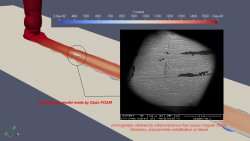Manufacture of high performance soft magnetic materials by melt spinning

The methodology is to design a master alloy with different starting compositions, to which Fe is added to get the desired atomic ratio of components. With this starting alloy, using the method of melt spinning, are achieved amorphous ribbons (FeSiB) with desired soft magnetic behavior. Then these ribbons are thermally treated for achieve nanocrystalline structures to improve the performance in the magnetic cores.
The application of soft magnetic materials in the electrical or electronic industry has increased significantly thanks to the development of amorphous and / or nanocrystalline metallic glasses, mainly through the use of Melt Spining technology.
This is a technique used for the extremely rapid cooling of metals in the liquid state, and consists in a metal wheel (represented by the flat bottom surface in this photo) that can be cooled internally with water, and that rotates at high speed underneath a thin jet of liquid metal that is thrown at high pressure and temperature over the outer surface of the wheel from a nozzle that is at a determined gap of the same. The contact with the cold and flat surface of the wheel produces a cooling that causes an extremely rapid solidification that generates a very thin ribbon, which is what is observed in the figure.
The cooling rates that can be achieved by this technique are between 104 and 107 k / s and are those that cause the amorphization of these materials. Depending on their composition, they can become nanocrystallized. The turbulence involved in this reported transient lasts a few milliseconds, enough time to study the process with high-speed cameras in our laboratory.
Provided by CORDIS





















